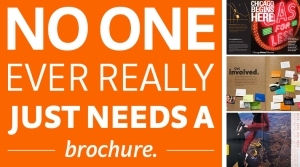7 Key Factors You Need to Know Before Hiring a “Graphic Designer”
There’s been a lot of discussion in recent years as to whether the term “graphic designer” accurately describes what we “graphic designers” really do these days. The change indicates an important shift in focus. And if you’re a business owner trying to understand who to hire to design your promotional materials, execute your website development, who can offer you the best insight about what direction to take in your marketing plans, you’ll want to read on!
Back when I started in this business, we were called “commercial artists.” And that really dates me! We also didn’t work on computers. We drew our layout concepts by hand, and one highly admired skill was the ability to accurately sketch different type styles: Helvetica, Garamond, Bodoni and so on.
But with the rise of personal computers and desktop publishing software, the basic tools of typesetting, page layout and even image manipulation came into the reach of everyone. And suddenly anyone who could paste clip art into a Word document became a “graphic designer.” And anyone with Adobe Creative Suite considered themselves qualified to hang out a shingle.
These developments have generated a debate about the term “graphic design” itself. The professional association AIGA (American Institute of Graphic Design) defines the term in a more or less traditional way: “Graphic design is a creative process that combines art and technology to communicate ideas. The designer works with a variety of communication tools in order to convey a message from a client to a particular audience. The main tools are image and typography.”
Of course, to an “old-timer” like me, that’s what good graphic design was always about – not just making pretty things but crafting effective communications that achieve the client’s objectives.
Here are just a few of the things that an effective graphic designer (or communications designer) has to be able to do. As a business owner, these are the points you will want to ensure your designer has a working understanding of and is capable of executing:
- Understand and think with your strategy: This might seem obvious, but it’s a point often missed by amateurs. What are you, the client, trying to achieve? Are you, the client, launching a startup in a competitive industry? Are you trying to expand into a promising new market? Are you moving from retail sales to e-commerce? A good designer has to understand the client’s industry, products, sales channels and competition.
- Understand the client’s markets: Who are you, the client, trying to communicate to? Are the client’s customers other businesses? Are you marketing to distributors or retailers? Are you after a niche market? A real understanding of markets and potential customers drives all later design decision. A designer needs to understand this.
- Organize information: I would say this is one of the primary skills of the graphic designer. In a very real sense, graphic design is the organization of information so that it is clear, simply laid out and easy to assimilate. Whether in a magazine ad, a brochure, or a website, the graphic designer takes the complexity of your business, boils it down to its essentials, and effectively presents it to the potential customer.
- Communicate: It is communication ability, not software, that defines the true professional designer. Anyone can fire up Word or InDesign or Dreamweaver and throw some copy and pictures on a page. But are they the right words and the right images to effectively achieve the client’s goals

- Understand communication channels: Today this is more important than ever. Should you, the client, be using social media? Should you have a company Facebook page? A blog? What should your LinkedIn profile say? Should you have one-sheet flier or a tri-fold brochure? What should your website navigation accomplish? The effective designer has to have the knowledge to guide a client through the labyrinth of communications media and advise on the most effective ones for that client.
- Have an awesome visual vocabulary: Every type font communicates something different. Every shape has its own message. Colors are their own language. Combining images, words, type fonts, shapes and colors to convey an exact message and achieve the client’s goal is a real art. It takes training and experience. Maybe those years of hand-drawing typefaces paid off after all!
- Know their technology: Sure, the designer has to know their software. They have to be a master at Photoshop, InDesign, Illustrator. They have to know how to put together a website or a blog. But unless they have all of these other skills in place, the designer will just be a technician.
Looking for a “graphic designer”? Maybe you’re looking for much more.
What have your experiences been when trying to find the right designer for your promotional items?








